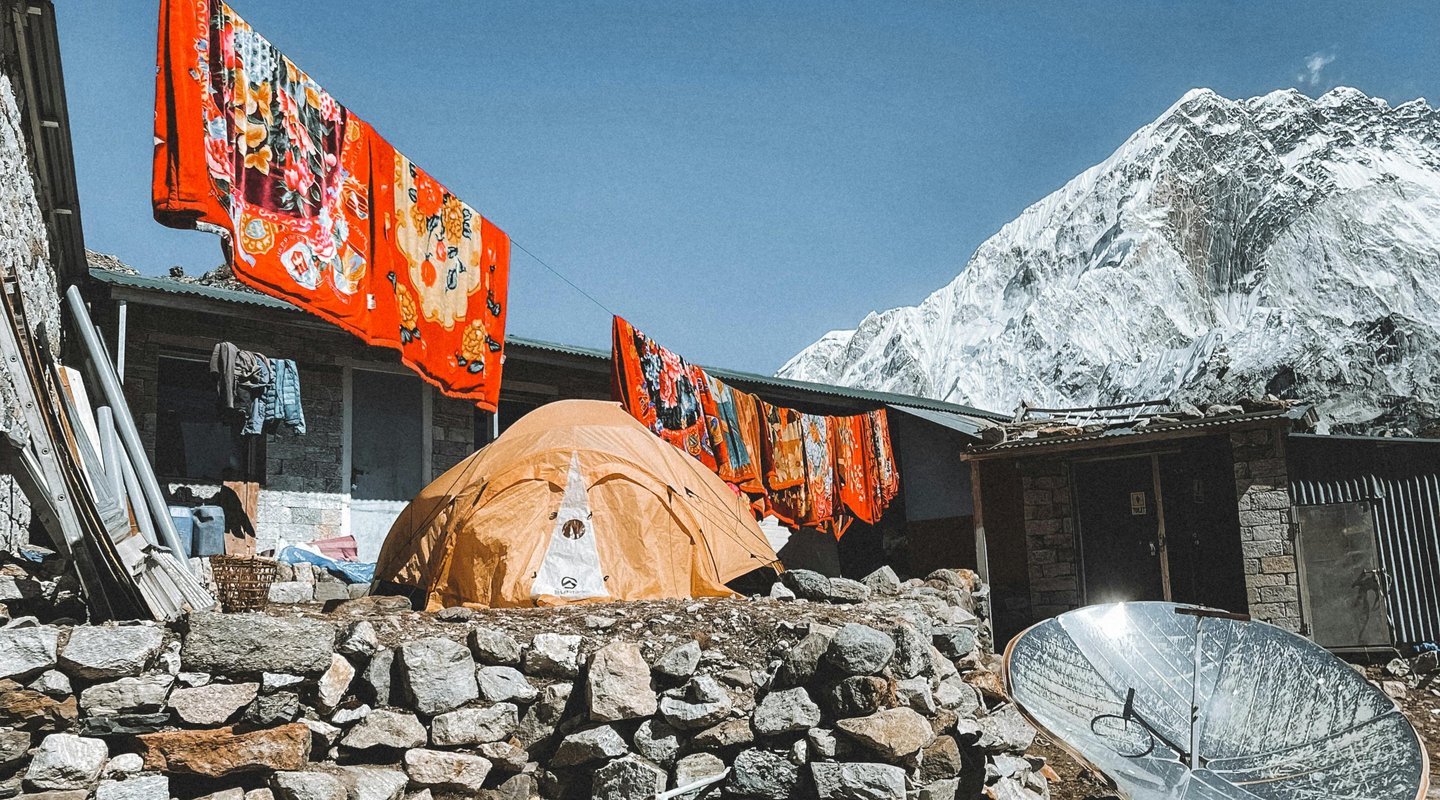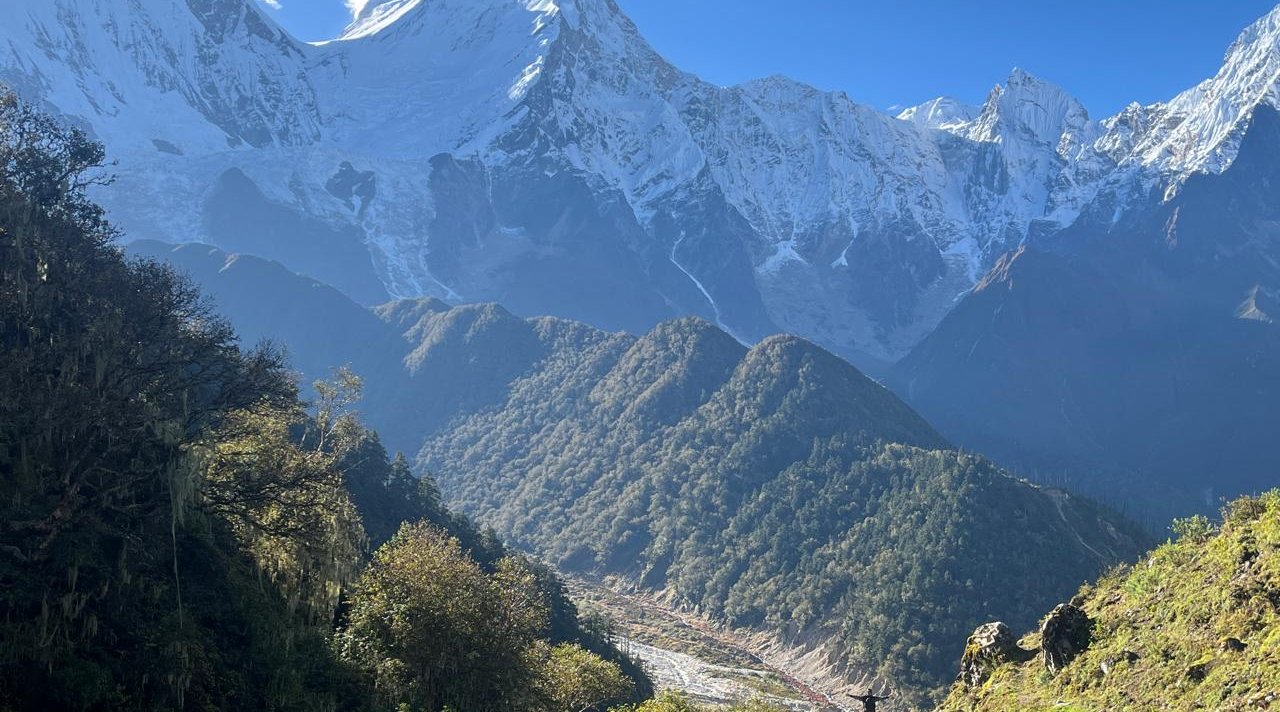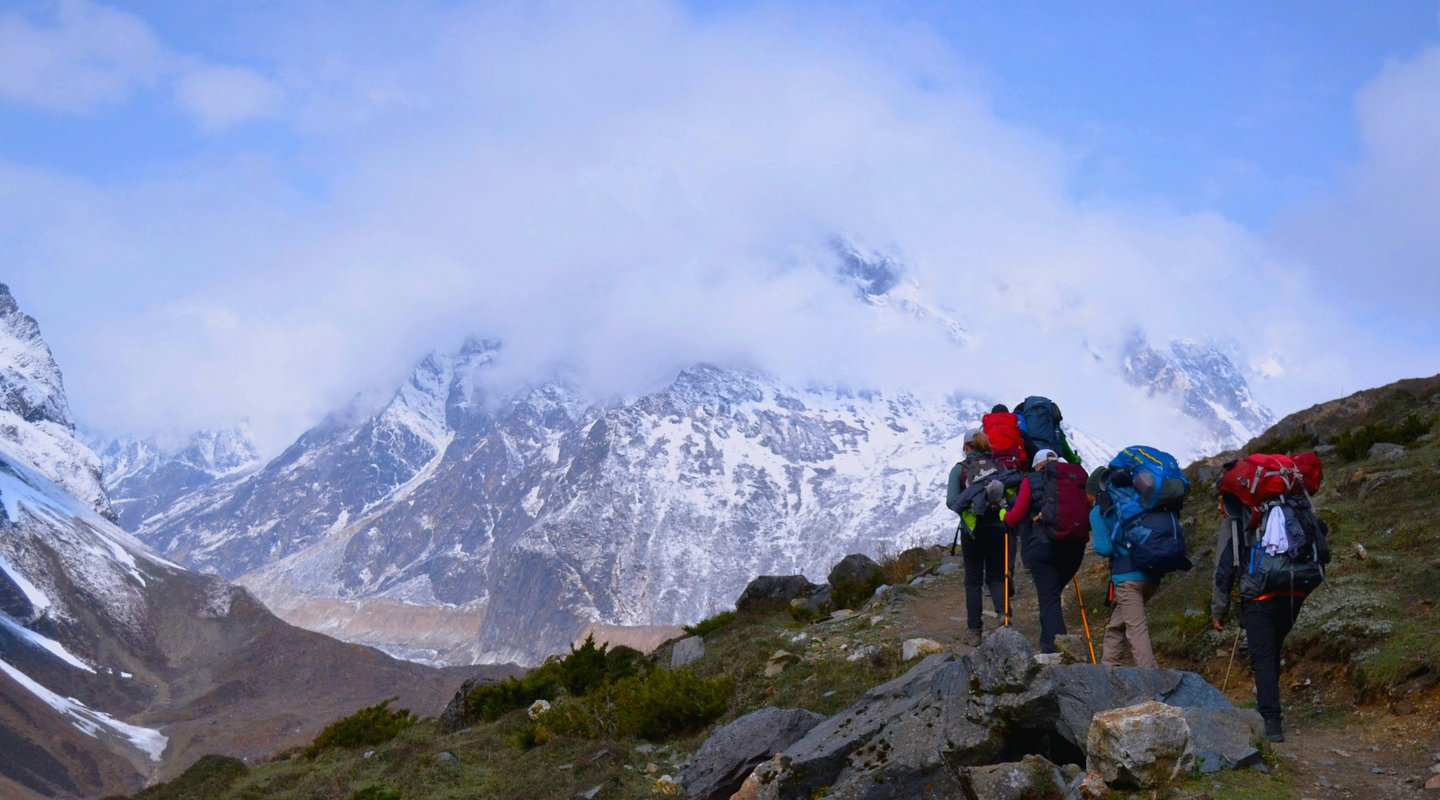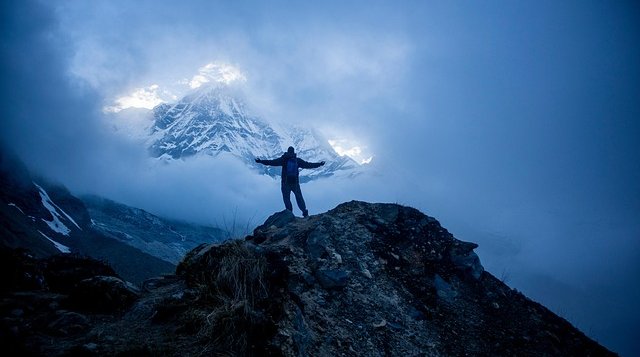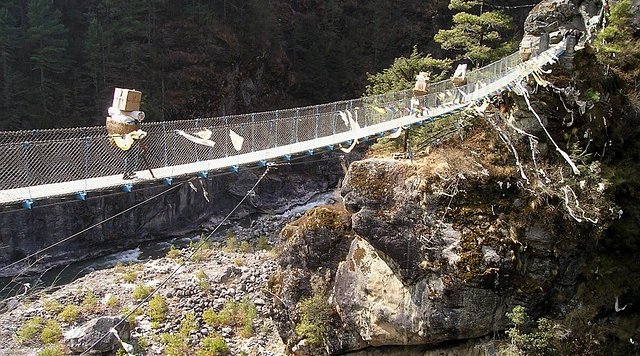Standing at the foot of the world's highest mountain isn't just a trek – it's a journey that transforms you. The Everest Base Camp trek draws thousands of adventurers annually to Nepal's Khumbu region, each seeking their own personal summit. Whether you're dreaming of touching the sky at Kala Patthar or simply yearning to immerse yourself in Sherpa culture, this comprehensive guide will walk you through everything you need to know about the EBC trek. For a complete overview of all your trekking options, see our Ultimate Guide to the Everest Base Camp Trek.
Quick Navigation
- Why Choose the Everest Base Camp Trek?
- Two Routes to Base Camp: By Flight vs. By Road
- Best Time to Do EBC Trek
- Complete EBC Trek Itinerary
- How Difficult is the EBC Trek?
- Physical & Mental Preparation Guide
- Health, Safety & Acclimatization
- EBC Trek Cost Breakdown
- Essential Packing List
- Cultural Highlights Beyond the Mountains
- EBC vs. Other Himalayan Treks
- Booking Your Adventure
Why Choose the Everest Base Camp Trek?
The Everest Base Camp journey offers something no other trek can match – the chance to stand where mountaineering legends have stood, surrounded by the world's highest peaks. But this trek is about more than just mountains.
What makes EBC special:
- Accessible adventure: Unlike climbing Everest itself, reaching base camp requires no technical climbing skills
- Cultural immersion: Experience authentic Sherpa culture in villages that have remained unchanged for centuries
- Spiritual journey: Visit ancient monasteries including the renowned Tengboche Monastery
- Personal achievement: Push your limits while trekking through Sagarmatha National Park, a UNESCO World Heritage site
- Stunning diversity: From lush valleys to the stark beauty of the Khumbu Glacier
Every step brings new wonders, from colorful prayer flags fluttering against snow-capped peaks to the warm hospitality of tea houses where trekkers gather to share stories.
Two Routes to Base Camp: By Flight vs. By Road
Most trekkers know about the classic Lukla flight, but there's an alternative that deserves attention – the overland route. Let's explore both options to help you make the best choice for your adventure.
The Classic Route: Flying to Lukla
The traditional EBC trek begins with an exhilarating 35-minute flight from Kathmandu to Lukla, often called the world's most dangerous airport. This tiny mountain airstrip sits at 2,860 meters, with a runway that seems to end at a cliff edge.
Advantages:
- Time-efficient: Start trekking immediately upon arrival
- Dramatic introduction: The flight itself is an adventure
- Standard itinerary: Most tour operators use this route
Considerations:
- Weather delays are common (pack 2-3 buffer days)
- Higher initial altitude means less gradual acclimatization
- Flights can be canceled for days during monsoon or winter
The Road Less Traveled: Overland Journey
The by-road route to Everest Base Camp is gaining popularity among trekkers seeking better acclimatization and a more immersive experience.
The overland journey involves:
- Drive from Kathmandu to Salleri/Phaplu (8-10 hours)
- Trek to Lukla (2-3 days)
- Join the main EBC trail
Key advantages of the road route:
- Superior acclimatization: Extra days at lower altitudes significantly reduce altitude sickness risk
- Cost savings: Avoid expensive Lukla flights (EBC trek cost reduced by $400-500)
- Cultural immersion: Pass through traditional villages rarely seen by tourists
- Weather independence: No flight cancellation worries
- Scenic diversity: Experience more varied landscapes
Route Comparison: By Flight vs. By Road
Total Duration
- By Flight: 12–14 days
- By Road: 16–19 days
Starting Altitude
- By Flight: 2,860m (Lukla)
- By Road: Gradual ascent starting from 2,400m
Cost Difference
- By Flight: Standard package pricing
- By Road: Save $400–500
Acclimatization
- By Flight: Good (requires proper rest days)
- By Road: Excellent (more gradual altitude gain)
Weather Risk
- By Flight: High (frequent Lukla flight delays)
- By Road: Low (less weather dependency)
Cultural Experience
- By Flight: Standard exposure to Sherpa culture
- By Road: Enhanced, with added village experiences
Physical Demand
- By Flight: Moderate–High (steeper ascent from Lukla)
- By Road: Moderate (more gradual trail)
Best For
- By Flight: Time-conscious trekkers
- By Road: Trekkers prioritizing safety and cultural immersion
Best Time to Do the EBC Trek
Timing your Everest Base Camp trek correctly can make the difference between a life-changing adventure and a challenging ordeal. Nepal's mountain weather follows predictable patterns, offering two prime windows for trekking.
Peak Season: October to November
Autumn brings crystal-clear skies and stable weather to the Khumbu region. This is when you'll capture those postcard-perfect photos of Everest.
Why autumn works:
- Visibility: Clear mountain views are almost guaranteed
- Temperature: Comfortable days (12-15°C), cold but manageable nights (-5°C)
- Trails: Dry and stable after the monsoon
- Atmosphere: Buzzing with fellow trekkers and festive energy
The trade-off: Popular tea houses fill quickly, and trails can feel crowded, especially around Namche Bazaar.
Spring Season: March to May
Spring offers its own magic, with rhododendrons painting the lower valleys in vibrant colors.
Spring advantages:
- Moderate crowds: Fewer trekkers than autumn
- Warmer nights: Slightly more comfortable sleeping temperatures
- Expedition season: Witness climbing teams preparing for summit attempts
- Flora: Blooming flowers at lower altitudes
Consider: Occasional spring storms and slightly hazier views than autumn.
Off-Season Considerations
Winter (December-February): Possible but challenging. Extreme cold (-15°C at night), some tea houses close, but you'll have trails to yourself.
Monsoon (June-September): Generally not recommended. Clouds obscure views, trails become slippery, and Lukla flights face frequent cancellations.
Complete Everest Base Camp Itinerary
Here's the classic Everest Base Camp itinerary that balances challenge with proper acclimatization. Remember, flexibility is key – your body's adjustment to altitude should guide your pace.
Day 1-2: Kathmandu to Phakding
- Fly to Lukla (2,860m) or arrive via road trek
- Easy 3-hour walk to Phakding (2,610m)
- Cross suspension bridges adorned with prayer flags
- First glimpse of the Himalayan lifestyle
Day 3-4: Phakding to Namche Bazaar
- Challenging day: 6-hour uphill trek
- Enter Sagarmatha National Park
- Steep climb to Namche Bazaar (3,440m)
- First views of Everest (weather permitting)
Day 5: Acclimatization Day in Namche
- Critical for success: Don't skip this rest day
- Optional hike to Everest View Hotel
- Explore the vibrant Saturday market
- Visit the Sherpa Museum
Day 6-7: Namche to Tengboche
- Trek through rhododendron forests
- Stunning views of Ama Dablam
- Reach Tengboche Monastery (3,860m)
- Attend evening prayers (highly recommended)
Day 8-9: Tengboche to Dingboche
- Descend through forests, then climb to Pangboche
- Enter the alpine zone above tree line
- Reach Dingboche (4,410m)
- Views become increasingly dramatic
Day 10: Acclimatization Day in Dingboche
- "Climb high, sleep low" principle
- Hike to Nagarjun Hill (5,100m)
- Return to Dingboche for sleep
- Critical for preventing altitude sickness
Day 11-12: Dingboche to Lobuche
- Trek across the terminal moraine
- Pass memorials to fallen climbers
- Reach Lobuche (4,940m)
- Prepare mentally for base camp push
Day 13: Lobuche to Gorak Shep to EBC
- The big day: Early start essential
- Trek to Gorak Shep (5,170m)
- Continue to Everest Base Camp (5,364m)
- Celebrate at the prayer flag-covered viewpoint
- Return to Gorak Shep for overnight
Day 14: Kala Patthar and Descent
- Pre-dawn start for Kala Patthar (5,545m)
- Best views of Everest summit at sunrise
- Descend to Pheriche or Pangboche
- Begin the journey home
Day 15-17: Return to Lukla
- Retrace steps through familiar villages
- Enjoy lower altitudes and thicker air
- Celebrate completion in Lukla
How Difficult is the EBC Trek?
Let's address the question every prospective trekker asks: "How difficult is the EBC trek?" The honest answer combines physical, mental, and environmental challenges that vary for each individual.
Physical Demands
The Everest Base Camp trek is rated as moderately difficult. You don't need to be an athlete, but you do need preparation.
What you'll face:
- Daily hiking: 5-8 hours of walking
- Total distance: Approximately 130km round trip
- Elevation gain: Over 2,500m from Lukla
- Terrain: Rocky paths, suspension bridges, occasional steep sections
The reality check: If you can hike for 6 hours with a daypack in your local hills, you can likely handle EBC with proper training.
The Altitude Factor
Altitude is the trek's biggest challenge. Above 3,000m, your body works harder for oxygen, making everything more difficult.
Common experiences:
- Shortness of breath during exertion
- Disrupted sleep patterns
- Reduced appetite
- Mild headaches (usually manageable)
Important: These are normal responses. Serious altitude sickness affects only 1-2% of trekkers who follow proper acclimatization protocols.
Mental Challenges
The mental game is often underestimated. Successful trekkers maintain positive attitudes despite:
- Basic accommodation conditions
- Limited food variety
- Cold temperatures
- Physical discomfort
- Being away from modern conveniences
Pro tip: Focus on small daily goals rather than the distant base camp objective.
Physical & Mental Preparation Guide
Success on the EBC trek starts months before you board the plane to Nepal. Here's your comprehensive preparation roadmap. Also check out our detailed guide on training plan for Everest Base camp trek.
Physical Training Program (12-16 weeks before)
Build your foundation with a graduated training approach:
Weeks 1-4: Base Building
- Walk 30-45 minutes daily
- Include hills or stairs twice weekly
- Add a weekend hike (2-3 hours)
- Focus on consistency over intensity
Weeks 5-8: Intensity Increase
- Extend daily walks to 1 hour
- Incorporate stair climbing (20-30 floors)
- Weekend hikes: 4-5 hours with elevation gain
- Add light strength training (squats, lunges, core)
Weeks 9-12: Trek Simulation
- Back-to-back hiking days
- Carry a weighted pack (8-10kg)
- Practice on varied terrain
- Include one 6-8 hour hike weekly
Weeks 13-16: Peak & Taper
- Maintain fitness without overtraining
- Focus on flexibility and recovery
- Practice with all your gear
- Gradually reduce intensity in final week
Mental Preparation Strategies
Your mind needs training too. The Everest Base Camp journey tests mental resilience as much as physical fitness.
Visualization techniques:
- Spend 10 minutes daily imagining yourself successfully trekking
- Visualize overcoming challenges (weather, fatigue, altitude)
- Picture yourself at base camp and Kala Patthar
Build mental toughness:
- Practice discomfort in training (cold, rain, fatigue)
- Set incremental goals during long training hikes
- Develop positive self-talk strategies
- Read trek journals for realistic expectations
Practical preparation:
- Learn basic Nepali phrases (locals appreciate the effort)
- Study the route and key landmarks
- Connect with past EBC trekkers online
- Prepare for limited connectivity (download offline entertainment)
Health, Safety & Acclimatization
Your safety on the Everest Base Camp trek depends on understanding and respecting the mountain environment. Let's dive deep into keeping yourself healthy at altitude.
Understanding Altitude Sickness
Altitude sickness isn't about fitness – it's about how your individual body adapts to reduced oxygen. Even Olympic athletes can suffer while sedentary individuals thrive.
Three levels of altitude sickness:
- Acute Mountain Sickness (AMS)
- Affects 50-60% of trekkers mildly
- Symptoms: Headache, nausea, fatigue
- Treatment: Rest, hydration, mild painkillers
- High Altitude Pulmonary Edema (HAPE)
- Rare but serious (1-2% of trekkers)
- Symptoms: Severe breathlessness, cough, chest tightness
- Treatment: Immediate descent and evacuation
- High Altitude Cerebral Edema (HACE)
- Very rare but life-threatening
- Symptoms: Confusion, loss of coordination
- Treatment: Emergency evacuation
The Golden Rules of Acclimatization
"Climb high, sleep low" – This principle saves lives on the EBC trek.
Essential practices:
- Ascend gradually: Never sleep more than 500m higher than previous night above 3,000m
- Rest days are mandatory: Not optional, regardless of how good you feel
- Hydration is key: Drink 4-5 liters daily (your urine should be pale yellow)
- Listen to your body: Mild symptoms are normal, worsening symptoms mean stop ascending
- Diamox consideration: Consult your doctor about acetazolamide for prevention
Daily Health Monitoring
Morning check-in routine:
- Rate your headache (0-3 scale)
- Assess fatigue level
- Check appetite
- Monitor sleep quality
- Test balance and coordination
Warning signs requiring descent:
- Symptoms worsening despite rest
- Severe headache unresponsive to medication
- Repeated vomiting
- Difficulty breathing at rest
- Confusion or altered mental state
Comprehensive Safety Measures
Travel insurance is non-negotiable. Ensure your policy covers:
- Trekking up to 6,000m altitude
- Helicopter evacuation (can cost $5,000+)
- Medical treatment in Kathmandu
- Trip cancellation/interruption
Additional safety tips:
- Carry a first-aid kit with blister treatment
- Use water purification tablets or UV sterilizer
- Protect against sun (SPF 50+, sunglasses, hat)
- Maintain hygiene (hand sanitizer is essential)
- Consider hiring a guide for safety and cultural insights
EBC Trek Cost Breakdown
Understandingthe true EBC trek cost helps you budget realistically. Here's a transparent breakdown of all expenses you'll encounter.
International Flight
- Budget Option: $800–1,200
- Standard Option: $1,200–1,500
- Comfort Option: $1,500–2,500
Nepal Visa (30 Days)
Lukla Flight (Round Trip)
Trekking Permits (TIMS + Sagarmatha National Park)
Guide
- Budget Option: $0 (solo, no guide)
- Standard Option: $25–30 per day
- Comfort Option: $30–35 per day
Porter
- Budget Option: $0 (carry own backpack)
- Standard Option: $20–25 per day
- Comfort Option: $20–25 per day
Accommodation
- Budget Option: $5–10 per night
- Standard Option: $10–15 per night
- Comfort Option: $15–30 per night
Meals
- Budget Option: $25–30 per day
- Standard Option: $30–40 per day
- Comfort Option: $40–50 per day
Travel Insurance
- Budget Option: $150–200
- Standard Option: $200–300
- Comfort Option: $300–400
Gear (If Needed)
- Budget Option: $200–300
- Standard Option: $400–600
- Comfort Option: $600–1,000
Miscellaneous (Tips, Snacks, Charging, Showers, etc.)
- Budget Option: ~$200
- Standard Option: $300–400
- Comfort Option: $500+
Total Estimated Cost
- Budget: $2,500–3,000
- Standard: $3,500–4,500
- Comfort: $5,000–6,500
Money-Saving Tips
Smart budgeting without compromising safety:
- Book Lukla flights directly in Kathmandu (save $50-100)
- Share guide/porter costs with other trekkers
- Eat dal bhat (unlimited refills, nutritious, cheapest option)
- Avoid meat at higher altitudes (expensive and risky)
- Charge devices at lower altitudes (cheaper rates)
- Bring energy bars from home
- Consider the road route (save on flights)
Hidden Costs to Remember
- Hot showers: $3-5 per shower above Namche
- Device charging: $2-5 per hour at altitude
- WiFi: $5-10 per day (when available)
- Bottled water: $3-5 per liter at high camps
- Tips for guides/porters: 10-15% of their fee
- Kathmandu accommodation: 2-3 extra nights for delays
- Celebration dinner in Kathmandu: $20-30
Essential Packing List
Packing correctly for the Everest Base Camp trek means balancing preparedness with weight. Here's your comprehensive Packing checklist for the Everest Base Camp Trek.
Clothing Essentials
Base Layers:
- 2-3 moisture-wicking t-shirts
- 2 thermal underwear sets
- 3-4 pairs of trekking socks
- 3-4 pairs of liner socks
Insulation Layers:
- 1 fleece jacket
- 1 down jacket (critical for higher altitudes)
- 2 trekking pants
- 1 insulated pants for cold evenings
Outer Layers:
- Waterproof jacket with hood
- Waterproof pants
- Windproof gloves + warm mittens
- Sun hat and warm beanie
- Buff or neck gaiter
Footwear & Walking Gear
- Trekking boots: Broken in, ankle support essential
- Camp shoes: Lightweight for tea house wear
- Trekking poles: Reduce knee strain by 25%
- Gaiters: Keep snow/debris out of boots
Technical Equipment
Essential items:
- Sleeping bag: Rated to -15°C minimum
- Daypack: 25-30 liters
- Duffel bag: 60-80 liters (for porters)
- Headlamp + spare batteries
- Water bottles or hydration system (3L capacity)
- Water purification tablets/UV purifier
- Sunglasses (UV protection essential)
- Sunscreen SPF 50+
- Personal first aid kit
- Toiletries and wet wipes
Nice to have:
- Camera with extra batteries
- Power bank (20,000mAh recommended)
- Book or e-reader
- Cards or travel games
- Journal and pen
Cultural Highlights Beyond the Mountains
The Everest Base Camp trek offers profound cultural immersion that rivals its mountain views. The Khumbu region beats with the heart of Sherpa culture, offering insights into a way of life shaped by Buddhism and the world's highest peaks.
Tengboche Monastery: Spiritual Heart of the Khumbu
Perched at 3,860m with Ama Dablam as its backdrop, Tengboche Monastery is more than a rest stop – it's a spiritual experience. Built in 1916, rebuilt after earthquakes and fires, this monastery embodies Sherpa resilience.
Don't miss:
- Morning prayers (5:30 AM): The haunting sound of horns and chanting
- Mani Rimdu Festival (October/November): Masked dances depicting Buddhist teachings
- The meditation room: Feel centuries of devotion in the flickering butter lamp light
- Conversation with monks: Many speak English and share profound insights
Prayer Flags and Mani Walls: Sacred Landscapes
Every step reveals spiritual symbolism. Prayer flags aren't decorative – they carry mantras on the wind, blessing all beings. The five colors represent elements: blue (sky), white (air), red (fire), green (water), and yellow (earth).
Mani walls – stone tablets carved with "Om Mani Padme Hum" – line the trails. Always pass on the left, keeping them to your right, spinning prayer wheels clockwise as you go. These aren't just customs; they're participation in centuries-old blessings for safe passage.
Tea House Culture: Where Stories Converge
Tea houses are more than lodging – they're cultural crossroads where Sherpas, trekkers, and yak herders share stories around wood-burning stoves.
The tea house experience:
- Evening gatherings: Card games, shared meals, trekking tales
- Sherpa hospitality: Genuine warmth despite basic conditions
- Local cuisine: Try sherpa stew, tsampa porridge, and butter tea
- Cultural exchange: Learn Nepali words, share your culture
Pro tip: Bring printed photos of your family – Sherpas love sharing family stories and seeing glimpses of life beyond the mountains.
Living Heritage: The Sherpa Way
Sherpas aren't just guides – they're the soul of the Himalayas. Their Buddhism isn't practiced; it's lived through:
- Compassion for all beings: Notice how they avoid stepping on insects
- Respect for mountains: Peaks are sacred, not conquered
- Community over individual: Success is shared, challenges faced together
- Adaptation and resilience: Thriving where others merely survive
Meaningful interactions:
- Learn to say "Namaste" (hello) and "Dhanyabad" (thank you)
- Ask about yak herding, not just climbing
- Respect photography preferences at religious sites
- Support local businesses beyond just tea houses
EBC vs. Other Himalayan Treks
How does the Everest Base Camp trek compare to other iconic Himalayan adventures? This comparison helps you choose the trek that matches your dreams.
Duration
- EBC: 12–14 days
- Annapurna Circuit: 16–21 days
Maximum Altitude
- EBC: 5,545 m (Kala Patthar)
- Annapurna Circuit: 5,416 m (Thorong La Pass)
Difficulty
- EBC: Moderate
- Annapurna Circuit: Moderate–Challenging
Scenery
- EBC: Glaciers, iconic Himalayan peaks including Mount Everest
- Annapurna Circuit: Diverse landscapes — rivers, valleys, alpine passes, and subtropical forests
Culture
- EBC: Predominantly Sherpa Buddhist traditions
- Annapurna Circuit: Blend of Hindu and Buddhist cultural influences
Crowds
- EBC: High during trekking season (spring & autumn)
- Annapurna Circuit: Moderate, spread out over longer routes
Infrastructure
- EBC: Well-developed teahouses and trekking infrastructure
- Annapurna Circuit: Variable — good in some regions, basic in remote sections
Unique Feature
- EBC: Trek to the base of the world’s highest mountain
- Annapurna Circuit: Cross the world’s deepest gorge (Kali Gandaki)
Choose EBC if: You dream of Everest specifically and prefer better infrastructure.
Choose Annapurna if: You want more ecological diversity and fewer crowds.
EBC vs. Annapurna Base Camp
The Annapurna Base Camp trek offers a shorter alternative with its own magic. Also, check out our detailed blog on the EBC vs Annapurna Base Camp trek. Also, check out our other Himalayan treks.
Key differences:
- ABC duration: 7-10 days (more flexible for time-limited trekkers)
- Altitude: Lower maximum (4,130m) means less altitude risk
- Scenery: 360-degree amphitheater of peaks
- Difficulty: Easier than EBC, good for first-time trekkers
EBC vs. Manaslu Circuit
The Manaslu Circuit remains Nepal's hidden gem.
Manaslu advantages:
- Restricted area preserves authentic culture
- Fewer than 10% of EBC's trekker numbers
- Similar scenery, more remote experience
- Slightly lower costs
EBC advantages:
- Better emergency evacuation infrastructure
- More tea house options
- Flexible itinerary possibilities
- Iconic status and name recognition
EBC vs. Langtang Valley
Langtang offers Himalayan trekking closer to Kathmandu.
Consider Langtang for:
- Shorter trek (7-10 days)
- Lower altitude (maximum 4,984m)
- Post-earthquake rebuilding support
- Budget-friendly option
Choose EBC for:
- Bucket-list achievement
- Superior mountain views
- Better infrastructure
- Cultural immersion depth
Booking Your Adventure
You've made the decision – Everest Base Camp awaits. Now comes the practical matter of turning dreams into itinerary. Here's how to move forward with confidence.
Independent vs. Guided Trekking
Independent trekking appeals to experienced hikers seeking flexibility:
- Complete freedom over pace and schedule
- Direct interaction with tea house owners
- Cost savings of $500-1,000
- Personal sense of achievement
Requirements for solo trekking:
- Previous high-altitude experience recommended
- Navigation skills and map reading
- Emergency response knowledge
- Travel insurance with evacuation coverage
Guided trekking offers peace of mind:
- Local expertise and cultural interpretation
- Established accommodation bookings
- Emergency response protocols
- Group camaraderie and support
- Porter arrangements handled
Choosing the Right Operator
Red flags to avoid:
- Prices significantly below market rate
- No mention of porter welfare policies
- Vague itineraries lacking acclimatization days
- No emergency evacuation plan
- Poor reviews regarding safety
Green flags to seek:
- Detailed day-by-day itineraries
- Clear acclimatization schedule
- Porter welfare commitments (insurance, proper gear)
- Maximum group sizes stated
- Responsive pre-trip communication
- Sustainable tourism practices
Pre-Departure Checklist
6 months before:
- Book your trek dates
- Start physical training
- Check passport expiration (needs 6+ months validity)
3 months before:
- Purchase travel insurance
- Book international flights
- Schedule doctor consultation
- Begin altitude training if possible
1 month before:
- Finalize gear purchases
- Obtain Nepal visa (online available)
- Exchange currency or arrange ATM cards
- Download offline maps and entertainment
1 week before:
- Pack and weigh your bags
- Confirm all bookings
- Share itinerary with emergency contacts
- Check weather forecasts
Final Preparations
Health considerations:
- Dental check-up (no dentists at altitude)
- Update vaccinations (Hepatitis A/B, Typhoid recommended)
- Prescription medications (bring extras)
- Consider Diamox consultation
Financial planning:
- Bring cash (limited ATMs beyond Namche)
- Small bills for tea houses
- Emergency fund ($500 recommended)
- Tips for guides/porters
Your Everest Journey Awaits
The Everest Base Camp trek isn't just about reaching a destination – it's about discovering your own strength while walking in the footsteps of legends. From the heart-stopping Lukla flight to the prayer flag-adorned Everest Base Camp, every moment writes itself into your personal story of achievement.
Whether you choose the classic route or the enriching overland journey, whether you trek in autumn's clarity or spring's blooms, the Khumbu region offers transformation. You'll return with more than photos of Kala Patthar at sunrise or Tengboche Monastery against Ama Dablam. You'll carry the warmth of Sherpa smiles, the wisdom found in mani walls, and the confidence that comes from standing at 5,364 meters, knowing you earned every step.
The mountains are calling. Your comprehensive guide is complete, your questions answered, your concerns addressed. The EBC trek cost is clear, the Everest Base Camp itinerary laid out, and the answer to "how difficult is the EBC trek?" honestly provided. What remains is the most important step – the first one.
Ready to begin your journey? Research specific tour operators that align with your values, connect with recent trekkers in online communities, and start that training program today. The best time to do EBC is when you're prepared, motivated, and ready for adventure.
The summit of your dreams isn't Everest itself – it's the moment you decide to chase them. Your Everest Base Camp trek story starts now.
Contact our expert team to customize your perfect Everest Base Camp experience:

